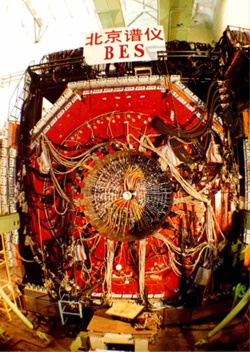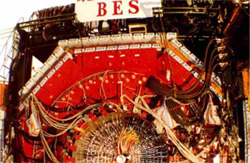

An international team of Beijing Spectrometer (BES) has discovered a new subatomic particle, which is making physicists reconsider their basic understanding about the properties of the interactions between quarks.
An international team of Beijing Spectrometer (BES) has discovered a new subatomic particle, which is making physicists reconsider their basic understanding about the properties of the interactions between quarks.
As reported in the July 11 issue of
Physical Review Letters, a group of some 200 Chinese and U.S. scientists, has found a new particle with a mass of 1859 Mev and a pin zero through an analysis of 58 million J/y events at the Beijing Electron Positron Collider (BEPC).
Scientists believe it is a new particle after a detailed study has definitely excluded the possibility of explaining this particle by any known particles, says Prof. Chen Hesheng, director of the CAS Institute of High Energy Physics, where BEPC is located.
The important feature of this new particle is its narrow width, which is very different from that of a conventional meson - the composite of quark and anti-quark. Researchers think it could be a bound state of nucleon and anti-nucleon, or called baryonium state (multi-quark state), which was predicted by theorists long ago and has been much searched for by many physicists including BES collaboration.
The discovery, together with other recent discoveries of possible multi-quark states, suggests that the Quantum Chromodynamics (QCD) theory, our basic understanding of the strong interaction, can not satisfactorily explain all the relevant experimental results achieved so far, says IHEP physicist Jin Shan, head of the research team. The astonishing discovery is of significance to further develop the strong interaction QCD theory, comments Prof. J. Ellis, a theorist with European Organization for Nuclear Research.
The BES is a large-scale, general purpose solenoidal detector installed on the BEPC on the campus of the CAS Institute of High Energy Physics. The BES International Collaboration, which is composed of the physicists and graduate students from IHEP and more than 20 other domestic universities and research institutions, as well as from the U.S., the U.K., Japan and Korea, is dedicated to the study of t lepton and charm quark physics. J/y particle, a composite of charm quark and anti-charm quark, was discovered simultaneously at the Brookhaven National Laboratory and the Stanford Linear Accelerator Center in the United States in 1974 by Prof. S. Ting and Prof. B.Richter who were awarded the Nobel Prize for the discovery. The study of J/y decays provides us an ideal laboratory for the study of light hadron spectroscopy and charm physics. The number of J/y events currently collected at the BES/BEPC is one order higher than those collected at other experiments in the world.






